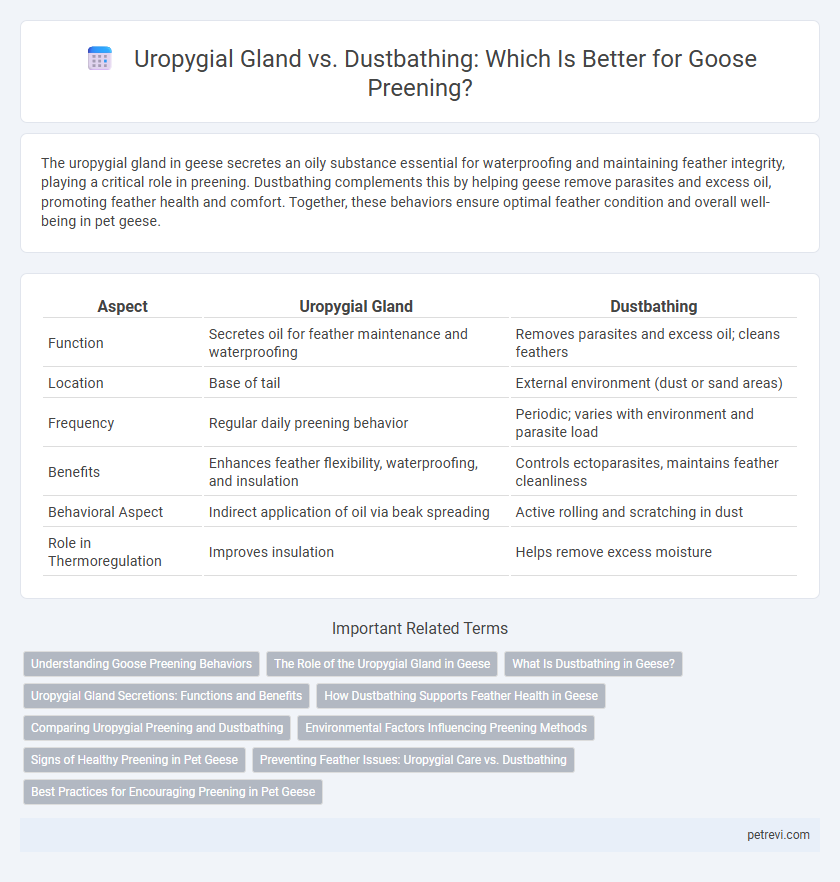The uropygial gland in geese secretes an oily substance essential for waterproofing and maintaining feather integrity, playing a critical role in preening. Dustbathing complements this by helping geese remove parasites and excess oil, promoting feather health and comfort. Together, these behaviors ensure optimal feather condition and overall well-being in pet geese.
Table of Comparison
| Aspect | Uropygial Gland | Dustbathing |
|---|---|---|
| Function | Secretes oil for feather maintenance and waterproofing | Removes parasites and excess oil; cleans feathers |
| Location | Base of tail | External environment (dust or sand areas) |
| Frequency | Regular daily preening behavior | Periodic; varies with environment and parasite load |
| Benefits | Enhances feather flexibility, waterproofing, and insulation | Controls ectoparasites, maintains feather cleanliness |
| Behavioral Aspect | Indirect application of oil via beak spreading | Active rolling and scratching in dust |
| Role in Thermoregulation | Improves insulation | Helps remove excess moisture |
Understanding Goose Preening Behaviors
Goose preening behaviors primarily involve the uropygial gland, which secretes oils essential for feather waterproofing and maintenance, enhancing insulation and buoyancy. Dustbathing complements this by helping remove excess oil, parasites, and debris, promoting feather health and comfort. Understanding these behaviors highlights the balance between oil application and cleanliness, critical for geese's survival and wellbeing.
The Role of the Uropygial Gland in Geese
The uropygial gland in geese plays a crucial role in maintaining feather health by secreting an oily substance that facilitates waterproofing and protects against microbial infections. This glandular secretion aids in preening behavior, ensuring feathers remain flexible and resilient, which is essential for insulation and flight. In contrast, dustbathing provides a complementary mechanism by mechanically removing parasites and excess oil, but the uropygial gland remains the primary source of feather conditioning in geese.
What Is Dustbathing in Geese?
Dustbathing in geese is a natural behavior where birds toss dust or soil over their feathers to remove excess oil and parasites, complementing the function of the uropygial gland. The uropygial gland secretes an oily substance that geese spread over their feathers during preening to maintain waterproofing and feather health. Dustbathing enhances this process by absorbing excess oil and dislodging external parasites, promoting optimal feather condition and hygiene.
Uropygial Gland Secretions: Functions and Benefits
The uropygial gland in geese produces oily secretions that play a crucial role in waterproofing and maintaining feather integrity by reducing feather brittleness and microbial growth. These secretions contain antimicrobial compounds that protect the skin and feathers from bacterial and fungal infections, enhancing overall plumage health. By distributing the gland's oils during preening, geese improve insulation and buoyancy, essential for thermoregulation and efficient water navigation.
How Dustbathing Supports Feather Health in Geese
Dustbathing plays a crucial role in maintaining feather health in geese by removing parasites, excess oils, and dirt that the uropygial gland's secretions cannot eliminate alone. This behavior helps distribute natural oils evenly across feathers, enhancing waterproofing and insulation while preventing feather degradation. Through regular dustbathing, geese complement the oil application from the uropygial gland, ensuring optimal preening and feather condition.
Comparing Uropygial Preening and Dustbathing
The uropygial gland in geese secretes oil that enhances feather waterproofing and maintains feather flexibility, crucial for effective insulation and flight. Dustbathing serves as a mechanical method to remove parasites and excess oil from feathers, supporting feather cleanliness but lacking the conditioning benefits provided by uropygial oil. Comparing both, uropygial preening primarily focuses on feather maintenance and protection, while dustbathing emphasizes parasite control and debris removal, highlighting their complementary roles in overall feather health.
Environmental Factors Influencing Preening Methods
Environmental factors significantly influence goose preening behaviors, with the uropygial gland playing a vital role by secreting oils that maintain feather waterproofing and flexibility. In contrast, dustbathing serves as a complementary method, helping to remove parasites and excess oils, particularly in dry or dusty habitats where gland secretions may be insufficient. Variations in humidity, temperature, and habitat substrate directly affect the reliance on these preening strategies, optimizing feather condition and overall health for geese in diverse ecosystems.
Signs of Healthy Preening in Pet Geese
Signs of healthy preening in pet geese include smooth, well-aligned feathers and a glossy appearance, indicating effective oil distribution from the uropygial gland. Regular dustbathing complements grooming by helping remove excess oil, dirt, and parasites, promoting skin health and feather maintenance. Observing these behaviors alongside clear, unbroken feather shafts suggests optimal preening and overall goose wellness.
Preventing Feather Issues: Uropygial Care vs. Dustbathing
The uropygial gland in geese secretes oils essential for maintaining feather waterproofing and flexibility, directly preventing issues such as brittleness and bacterial infections. Dustbathing complements this by removing excess oil, dirt, and parasites, reducing the risk of feather deterioration and skin irritation. Together, uropygial gland secretions and dustbathing form a synergistic defense against feather problems, ensuring optimal plumage health and insulation.
Best Practices for Encouraging Preening in Pet Geese
The uropygial gland in geese produces essential oil that maintains feather integrity and waterproofing, making stimulation of this gland crucial for healthy preening behavior. Providing regular access to dustbathing areas allows geese to effectively remove parasites and excess oil, supporting natural preening processes. Combining habitat enrichment with balanced nutrition optimizes uropygial gland function and encourages consistent, thorough preening in pet geese.
Uropygial gland vs Dustbathing for Goose Preening Infographic

 petrevi.com
petrevi.com